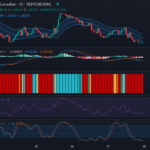EURUSD Analysis: Sideways Market Moves Amidst Trader Fear
Tháng 4 17, 2025
US Dollar vs Canadian Dollar: A Technical Deep Dive into The Downward Momentum – 18/04/2025
Tháng 4 17, 2025Japan’s March 2025 Consumer Price Index: Insights into Stable Inflation Trends
Japan’s economy is currently exhibiting a defined trend of stability, as indicated by the latest Consumer Price Index (CPI) data released for March 2025. The nationwide core CPI, which notably excludes volatile fresh food prices, has reported a year-over-year increase of 3.2%. This figure aligns perfectly with economists’ predictions, although it represents a slight decrease from the 3.7% rate observed in February. Such consistency in inflation rates is notable and highlights a balanced economic scenario amidst ongoing global uncertainties.
Understanding Japan’s Core CPI Landscape
The core CPI serves as an essential metric for understanding inflation trends, particularly in an economy like Japan’s, which has experienced prolonged periods of tampered inflation. The maintenance of a 3.2% rate suggests that inflation pressures are yet to intensify, providing the Bank of Japan (BOJ) with a reasonable degree of caution regarding future monetary policy actions. If the CPI had exceeded the February rate, it might have provoked a shift in the BOJ’s stance, potentially prompting a tightening cycle aimed at curbing inflation. However, the stability observed implies that the BOJ is likely to continue its measured approach to interest rate adjustments in the foreseeable future.
With the backdrop of evolving global trade scenarios—marked particularly by the recent tensions involving US tariffs—the BOJ is navigating a complex landscape. Governor Kazuo Ueda has stressed the importance of closely monitoring global trade dynamics and their potential implications for Japan’s economy. His comments signal a prudent and analytical approach towards upcoming policy decisions, reinforcing the commitment to maintain a stable economic environment while evaluating external risks. The implications of trade dynamics can also be seen broadly in the context of international relations, such as in this discussion on China’s strategic moves.
The Impact of Trade Policy on Japan’s Economic Strategy
Trade policies significantly influence not only inflation rates but also the broader economic dynamics within Japan. The recent extension of US tariff postponements on Japanese goods provides a slight reprieve for the BOJ, potentially influencing its decision-making on future rate hikes. Should inflation indicators begin to climb again, the central bank may reconsider its positions, but for the moment, the focus remains fixed on sustaining economic stability.
This wait-and-see strategy allows the BOJ to maintain a level of flexibility in an unpredictable global market. While inflation remains relatively controlled, the ongoing uncertainties require a cautious perspective. The BOJ’s current stance signifies a careful balance between supporting domestic economic growth and preemptively addressing any signs of rising inflation.
Conclusion: A Controlled Inflation Environment Ahead
In conclusion, the March 2025 CPI data points to a Japan characterized by persistent, yet manageable inflation. The core CPI’s stability at 3.2% marks an essential inflection point for economists and investors alike, indicating that while Japan’s economic indicators exhibit resilience, the BOJ is wise to remain vigilant amid fluctuating global trade conditions. This approach underlines Japan’s strategic positioning to safeguard its economic interests, making the navigation of trade uncertainties a top priority to maintain growth and stability in the coming months. As the situation develops, it will be crucial to observe how these elements will influence both the BOJ’s policy decisions and Japan’s overall economic health in the longer term.
